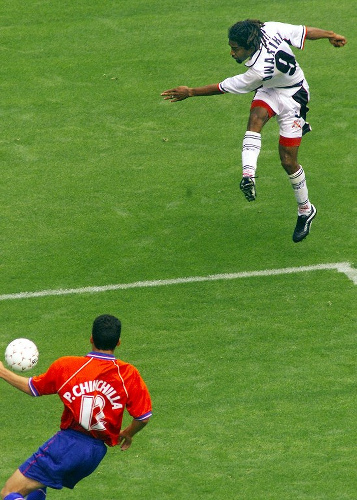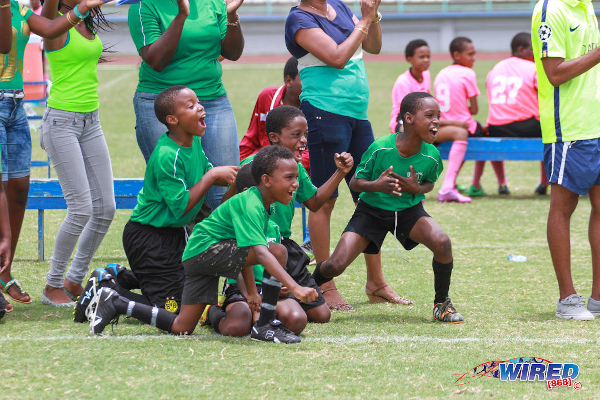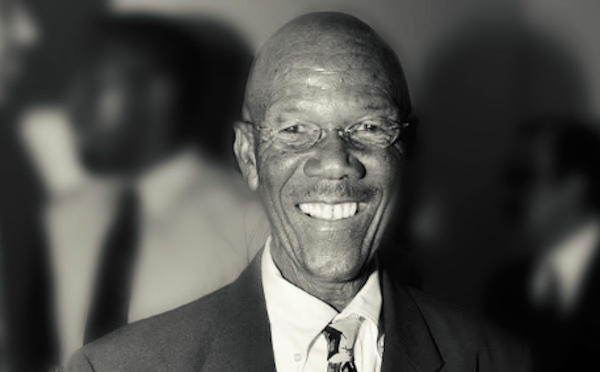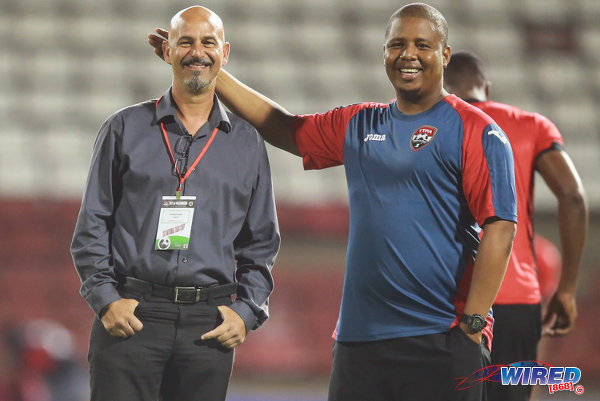So far I have only touched on youth development from a ball manipulation and decision-making viewpoint. However, playing in competitive games non-stop can also hinder the physical development and health of players.
Again, the local adage that ‘the more you play, the better you get’ is misleading on this count. Time must be spent strengthening players—especially in these modern times when our children live a more sedentary lifestyle than in past decades—and resting muscles that have been taxed. And, often, the two things can be combined.

(Copyright Kerlon Orr/CA-Images/Wired868.)
Bassam Naim, the founder and technical director of an Ontario-based academy named ANB Fútbol and a Uefa ‘A’ and CBF ‘A’ (Brazil’s top badge) licensed coach, told me that he advises parents to allow the player to ‘do anything other than soccer’ in the six week off-season of the Canadian soccer calendar.
More often than not, this involves playing another sport or taking up an activity which utilises a different muscle group. Other times, it involves doing nothing at all—usually for those kids carrying niggling injuries or pains.
I have seen first-hand how detrimental our calendar of non-stop competitions can be to young players. In 2017, I had a technically gifted midfielder at my Secondary Schools Football League (SSFL) team. He was two-footed and had a good game IQ. He was 15-years-old at the time.
We felt we would use him off the bench as much as possible that season to gain experience, so the following year, as a fifth form student, he would be our main guy in midfield.
During the course of that calendar year, the boy trained with his club and played in the Republic Bank Cup, and screened and was selected on his zone’s under-15 side before advancing to the Trinidad and Tobago National Under-15 team. He travelled to a Concacaf tournament that August with the national outfit.

(Copyright Allan V Crane/CA-Images/Wired868.)
He returned the week before the SSFL started and trained with the school’s first team, while he was a starter for our under-16 team which won the zonal league title, national league title, and lost the zonal knockout final on penalty kicks after extra time. Additionally, he played for roughly 15 minutes in each SSFL and Intercol game.
At the end of the 2017 season, I suggested to his father that the boy should do nothing for the next couple of months to allow him to recharge. But at that age boys always want to play and soon he was back training with his zonal team for another proposed tour.
The national team resumed training too and 2018 was just as busy for the boy as the previous year.
In that 2018 SSFL season, our staff made a decision not to use our first team players at under-16 level, although almost the entire squad was eligible. We recognised the danger; but we could not save the young man from his workload.

(Courtesy Allan V Crane/CA-images/Wired868.)
Soon, the boy’s parents noticed that everything was not right with him. He was having difficulty concentrating and holding his train of thought in conversations, which was unlike him. In training and games, he was flat and lacked his usual dynamism and penetration, while he complained about his legs feeling heavy and that he did not have energy.
A visit to the doctor and subsequent tests revealed that he was suffering from chronic fatigue syndrome. The doctor explained that tissue around his muscles were ‘swelling’—the best layman description I can give—each time he played, as if his body were trying to stop him from doing irreparable damage.
It was so bad that the doctor recommended he have two weeks of total rest from football. And when he got the go-ahead to rejoin training, it came with the caveat that he should not be used in games for more than 10-15 minutes.
Is that an extreme example? Maybe. Or maybe, the only reason we don’t hear of more cases like that is because most families do not have the means to pay for the doctor’s visit and battery of tests necessary to arrive at that diagnosis.

(Copyright Allan V Crane/CA-Images/Wired868.)
The non-stop calendar also manifests itself in injuries that are not allowed to heal and therefore become chronic.
Another player on that 2018 team also represented his zone and the same national youth team. He received a terrible tackle in the last game of the 2017 season and injured his knee.
The specialist said he was ‘very lucky’ to avoid surgery but the injury was serious and required nine weeks of intensive rehabilitation. The boy began rehab but, as soon as he started to feel better, he was out playing again.
I asked his parents to stop him and, to their credit, they did. But soon the national youth team staff called and he resumed practice before finishing his rehab. He was never close to his best and was eventually forced to stop in mid-season to see about his knee.
Is this constant grind of activity in the best physical interest of our young players?

(Courtesy Allan V Crane/Wired868.)
The SSFL remains the highlight of the youth football calendar. What most people do not know is that it changed from an under-19 to an under-21 competition when the Premier Division started in 2014; or maybe even a few years before then.
I believe this age increase, coupled with the Pro League’s termination of its reserve division around 2018, had a negative impact on player development.
I understand and appreciate that students are now entering secondary school as late as 15 years of age, due to changes made by the Ministry of Education. But this should not have changed schools football from being an under-19 competition in my humble opinion—and I mean for players 18 years and younger, unlike now where ‘under-16’ means for 16 years and below.
We have asked the league to return to being an under-19 competition but were always shut down at SSFL meetings. The argument for the status quo was: ‘once they are students, they are eligible’.

(via Daily Telegraph.)
For me, that response cannot come from anyone genuinely interested in player development and the preparedness of these students for the real world.
Frankly speaking, any boy who is 20-years-old and cannot make an adult team is not going to make a living out of football. As such, all energies should be directed towards helping that young man with his academics.
Of course, there will be exceptions. Germany defender and two-time World Cup finalist Hans-Peter Briegel only started organised football at age 17. Dennis Lawrence, the man whose goal took us to the 2006 World Cup, did not have a substantial SSFL career himself. But those are not the norms.
Conversely, any player who is good enough to play adult football but chooses to play in the SSFL is stunting his own development.
I can speak from experience here. I repeated lower six because I missed too much school that year. So in upper six, I was already 19 and could not play in what was then an under-19 competition. (I had already played in the SSFL for four seasons at that point.)

However, I was good enough to play senior club football and, while attending school and preparing for my A’ Level exams, I represented Carib Peterborough, which was coached by former Trinidad and Tobago Football Association (TTFA) technical director Kendall Walkes.
It benefitted my development immensely to play and train with the likes of then National Senior Team player George ‘Killer’ Sadlow and talented young men like Sean Byer, Sean Walkes and Calvin Strong—the latter trio were former national youth players who were all older than me.
I was called up to the National Under-23 Team the same year. The improvement in my game by mid-season was obvious.
Compare that to a far more naturally talented player who stayed in school football beyond its real usefulness to his development. In 2016, while acting as assistant coach for QPCC, I saw a player in a Super League game who caught my eye right away.

(Courtesy Chevaughn Christopher/Wired868.)
He was impressively built and, playing as a centre back, was able to step forward and give his team an additional midfielder when they were in possession. He looked calm and assured on the ball.
I asked my head coach, Shawn Cooper, if he knew the player.
“That is Kierron Mason,” he said. “He left school last year. Good player.”
Mason caused us headaches that game but I was happy to see a player who I had no doubt would soon make a fine national senior player.
However in 2017, on the opening day of the SSFL season, I saw the very same Kierron Mason playing for Shiva Boys Hindu College against Naparima. Madness! How does that help his development?
In that same season when Shiva Boys played Fatima, our 15-year-old five-foot-five National Under-15 midfielder Zach Welch had to come up directly against the 19-year-old six-foot-two Mason. How did that help either player?

(Courtesy Annalisa Caruth/Wired868.)
It did not challenge Mason, while it did nothing for Welch’s confidence.
The SSFL is full of mismatches like that due to the wide disparity in ages—particularly with schools who can rely on a core of older form six students. And it hurts the competitiveness of the product as well as the usefulness of the league as a developmental tool.
You can add to this the scheduling of two games per week, which I discussed in the previous column.
It may be tempting to think that the way things are has not changed over the decades; and that our current structure is what produced the quality players of my era like Russell Latapy, Dwight Yorke, Clint Marcelle, Colin Rocke, Marvin Faustin, Kerry Jamerson, Shaka Hislop, Ross Russell, Anthony Clarke, Timothy Haynes, Leonson Lewis, Carlos Lee, Sheldon and Brent Bennett.
And, just before our time, Ian Clauzel, Anton Corneal, Garth Pollonais, Veron Skinner, Errol Lovell, Hutson Charles, David Nakhid, Graeme Rodriguez and a long list of top youth players who went on to win National Senior Team caps and dominate Caribbean football and compete with the big boys in Concacaf.

(Courtesy ttfootballhistory.com.)
But that is not true.
We did not have the plethora of youth competitions that exist now. I can remember just one national tournament outside of the College’s League (now SSFL), which was the Sunshine Snacks competition.
Of course there were many minor leagues; but, for the most part, your football world centred around the schools football back then.
As a result, youth teams like the Jean Lillywhite Coaching School, Alcons and Harvard’s Sports Club could spend the better part of the year working on the technique, tactics, strength and conditioning of their players, before taking them abroad to play in competitions like the Dallas Cup or mini-tournaments in Brazil.
In training, repetition was your friend. Over and over, your 10 and 15 yard passes were practised, as was your control, shooting, and every technique required in the game. You worked on it until it became habit.

(Copyright Daniel Prentice/Wired868.)
Time was spent working on football actions and tasks like ‘jockeying’ (slowing down and engaging an opponent on the ball), showing an attacker towards the line or into the path of a covering player, tackling, etc.
The countless repetition of these actions not only ensured that individual players ‘got it’, but allowed defenders, as a unit, to understand each other’s unspoken communication based on the stance of a teammate and how he approached an opponent.
Coach Bertille St Clair underlined the benefit of repetition during a chat on The Burdie and Barney podcast, when he spoke about the work done with a young Dwight Yorke. And we all know the quality player he turned out to be.
At the national level, players in each age group from my day knew that if they performed well in school they would be selected for their zonal teams, which trained on selected evenings to work on the understanding of their players’ roles and functions. A player needed decent technique to be called up to even zonal level then.

(via Kreol Magazine.)
In fact, school players were so technically accomplished back then that, in 1985, there was a Big 4 competition involving Trintoc, Defence Force, Barataria Ball Players and College League champions San Fernando Technical Institute. And, if memory serves me correctly, San Fernando Tech held the mighty Defence Force to a scoring draw.
The same Defence Force who, that season, swept up five trophies including the 1985 Concacaf Club Championship title and lost 1-0 to Copa Libertadores winners, Argentinos Juniors (who included 1986 World Cup winner Sergio Batista), in the now defunct Copa Interamericana finals.
A number of players in my day played—or, in my case, tried to play—cricket in the off-season, such as Yorke and Eve. Others like Marcelle, Lewis and Rocke were into track and field. There is a long tradition of our schoolboys excelling in multiple sports, which was possible due to breaks in the football calendar that do not exist today.
Michael Jordan, Allen Iverson, Deion Saunders and Steve Nash are examples of players who competed in multiple sports up to collegiate level without harming their chances of success in their preferred field.

Before then, he played baseball in his off-season.
When did we get this idea that continuous football competitions is a necessary part of development? Have we seen an improvement in play or the players we produced because of it?
And, if not, why do we persist with this competition theory?
Editor’s Note: Click HERE for the fourth and final part of ‘Barney’s bible’, which offers suggestions to address the issues in Trinidad and Tobago’s youth development.
Click HERE to read the first column in the series, as Wayne Sheppard looked at the the best practices for player development and compares it with what exists at present in Trinidad and Tobago.
Wayne Sheppard is the Arima North Secondary technical director and ex-Men’s National U-15 assistant coach. He holds a TTFA ‘B’ coaching license and diplomas from USC, CANOC and TTOC.
He is the co-host of the Burdie and Barney Show and a former T&T National U-23 and U-17 player.
 Wired868 Wired868 for smart sport news and opinion
Wired868 Wired868 for smart sport news and opinion







Powerful commentary Barney.
DTA